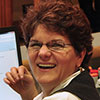This article is more than 5 years old.
ALA Midwinter in Seattle was about making connections (and sometimes missing connections). I had an endless travel day on Friday, along with Carolyn McCallum (the result of a missed connection) preventing me from attending sessions on the Future of the University Library, a disappointment. I focused on sessions related to assessment and building planning. The ACRL Metrics User Group Meeting provided a forum to discuss the capabilities and limits of using ACRL Metrics. The demonstration highlighted key capabilities including peer group comparisons, built-in report templates. Utilizing data supplied through NCES (National Center for Education Statistics), ALS (Academic Libraries Statistics) and IPEDS (Integrated Postsecondary Education Data System) the demonstration focused on how utilizing these metrics would help demonstrate value to our institution in ways that no single group of statistics can.
Roz, Susan and I all a session with the Medium Sized Library Discussion Group, that had the tantalizing discussion topic of “Giving up the Old to Do the New.” One library reported that they had stopped providing electronic reserves services, and instead just gave the responsibility over to faculty to scan documents directly into their Course Management System. She said that usage was declining precipitously. When I brought up how everyone was managing the transition to ebooks from print books, (if they were) there was a general belief that slow and steady was a wise pace to adopt. I exchanged email addresses with one librarian who had been doing a pretty consistent job of tracking the acceptance of ebooks by having focus groups with users over a period of 3 years. She shared her procedures and questions with me after the conference and we hope to do something similar soon. That was a very valuable connection.
I always enjoy the Speakers I hear at ALA conferences. While I found Steven Bell inspiring, I was entranced by Caroline Kennedy. She related a story of a public library in New York that was devastated by Superstorm (Hurricane?) Sandy. After the storm, the library opened in a makeshift building because their building was full of 4 feet of mud and filth. Their only collection was from the material that had been lent out to patrons during the storm that had since been returned. The hearty librarians soldiered on. I also attended a speech by Temple Grandin, prolific author and professor of Animal Sciences at Colorado State. Being the most famous adult with autism in the world her talk enlightened me not just on what she thought about the differences between visual and auditory learners, but also on HOW she thought. It was fascinating, and a little disorienting.
Lastly, I spent a good deal of time going to sessions related to Academic Libraries and how users use them. Not surprisingly, everyone recognizes the same need for more outlets, the same constrictions of space, the same desire to have spaces that are very flexible. Themes include: Information Commons, retractable cords, a certain level of acceptable messiness, variations of group study space (small, large, group, silent), group study v. individual study. More relevant to public libraries than academics was the idea of a Maker Space, that are flexible activity spaces that allow for continuous programming. The idea of Maker Spaces added to my “to do” list for what else the library has to become!

1 Comment on ‘MB @ ALAMW in Seattle’
Good report! Thanks Mary Beth. I’ve heard Dr. Grandin speak as well, she’s amazing.